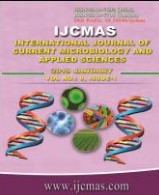


 National Academy of Agricultural Sciences (NAAS)
National Academy of Agricultural Sciences (NAAS)

|
PRINT ISSN : 2319-7692
Online ISSN : 2319-7706 Issues : 12 per year Publisher : Excellent Publishers Email : editorijcmas@gmail.com / submit@ijcmas.com Editor-in-chief: Dr.M.Prakash Index Copernicus ICV 2018: 95.39 NAAS RATING 2020: 5.38 |
A field experiment was conducted at Horticultural Research Station, Adilabad during kharif and rabi seasons of 2015-16 and 2016-17 to study the effect of integrated nutrient management practices on system productivity, profitability and economics of baby corn-hyacinth bean cropping system. The experiment was laid out in a randomized block design for baby corn during kharif, 2015 season with seven treatments comprised of 100% Recommended dose of fertilizer (RDF- 150:60:60 N, P2O5, and K2O kg ha-1) 25% N supplemented through Farm Yard Manure (FYM) or vermicompost (VC) + 75% RDF with or without soil application of Azospirillum and Bacillus megaterium@ 5 kg ha-1 each, in addition to control (no fertilizer application) and replicated thrice. Manures and inorganic fertilizers, P2O5 and K2O (single super phosphate and muriate of potash) incorporated into the soil before sowing as per the treatments. Nitrogen (urea) was applied in three splits at 10, 25 and 40 DAS. Each main treatment was divided into four sub plots and the treatments of 100% RDF and 75% RDF with or without Bradyrhizobium @ 500 g ha 1 (seed treatment) were imposed for hyacinth bean in rabiseason and data of kharif, 2016 and rabi, 2015-16 and 2016-17 was analysed in split plot design. Integrated use of 25% N through VC, bio-fertilizers and 75% RDF (inorganic) during kharif to baby corn and 100% RDF along with Bradyrhizobium seed treatment to hyacinth bean during rabi realized higher system productivity, gross returns, net returns, system profitability over rest of the treatments of 100% RDF with or without bio-fertilizers, 25% N through FYM with or without bio-fertilizers and 75% RDF, 25% N through VC + 75% RDF and unfertilized control during kharif followed by 75% RDF with or without seed treatment with Bradyrhizobium and 100% RDF alone to rabi hyacinth bean.
 |
 |
 |
 |
 |